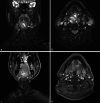[Malignant tumors of the oral cavity]
- PMID: 33025131
- PMCID: PMC7653794
- DOI: 10.1007/s00117-020-00756-5
[Malignant tumors of the oral cavity]
Abstract
Clinical/methodical issue: Oral cavity malignancies are the most common tumors in the field of ear, nose and throat medicine or otorhinolaryngology worldwide. It comprises a heterogeneous group of tumors, the knowledge of which is necessary to meet the different requirements of diagnostics and therapy.
Standard radiological methods: Computed tomography (CT), magnetic resonance imaging (MRI), sonography (US), nuclear medical procedures (NUK).
Performance: The above-mentioned diagnostics are used in a complementary manner.
Achievements: Early diagnosis of the tumor improves staging and thus the patient's therapy and prognosis.
Practical recommendations: The radiologist plays an important role in the interdisciplinary treatment of malignant tumors of the oral cavity. Despite great progress in radiotherapy, oncology and immunotherapy, surgery still plays an important role in the treatment of malignant diseases of the oral cavity.
Klinisches/methodisches Problem: Mundhöhlenmalignome stellen weltweit die häufigsten Tumoren im Bereich der Hals-Nasen-Ohrenheilkunde bzw. Otorhinolaryngologie dar. Es handelt sich um eine heterogene Gruppe an Tumoren, deren Kenntnis erforderlich ist, um den unterschiedlichen Anforderungen an Diagnostik und Therapie gerecht zu werden.
Radiologische Standardverfahren: Computertomographie (CT), Magnetresonanztomographie (MRT), Sonographie, nuklearmedizinische Verfahren (NUK).
Leistungsfähigkeit: Die o. g. Diagnostika werden komplementär eingesetzt.
Bewertung: Eine frühzeitigere Diagnose des Tumors verbessert das Staging und somit die Therapie und Prognose des Patienten.
Schlussfolgerung: Dem Radiologen kommt bei der interdisziplinären Behandlung von Malignomen der Mundhöhle eine bedeutende Rolle zu. Trotz großer Fortschritte in der Radiotherapie, Onkologie und Immuntherapie spielt die Chirurgie weiterhin eine wichtige Rolle in der Behandlung maligner Erkrankungen der Mundhöhle.
Keywords: Diagnostic imaging; Malignancy; Neoplasms; Otorhinolaryngology; Squamous cell carcinoma.
References
-
- Eveson JW, Pring M (2017) Oral Cavity. In: Cardesa A, Slootweg P, Gale N, Franchi A (Eds) Pathology of the Head and Neck. 2nd ed, pp 129–177. Springer, Berlin Heidelberg. 10.1007/978-3-662-49672-5_3 - DOI
Publication types
MeSH terms
LinkOut - more resources
Full Text Sources
Medical




